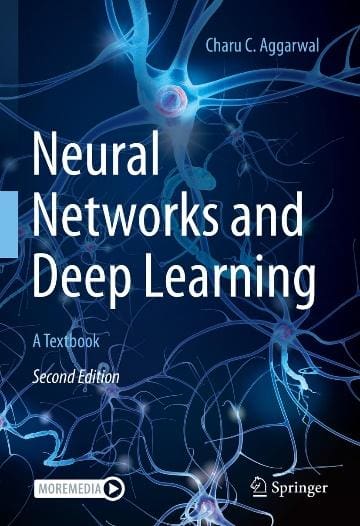Neural Networks and Deep Learning: A Textbook (2nd Edition)
The second edition of the book Neural Networks and Deep Learning is now available. This book covers both classical and modern models in deep learning. The book is intended to be a textbook for universities, and it covers the theoretical and algorithmic aspects of deep learning. The second edition is significantly expanded and covers many modern topics such as graph neural networks, adversarial learning, attention mechanisms, transformers, and large language models.
By Charu C. Aggarwal

Table of Contents
Publisher Page from Springer (Buy PDF e-copy or hardcopy)
Amazon Page (Buy hardcopy)
The chapters of this book span three categories:
- The basics of neural networks: The backpropagation algorithm is discussed in Chapter 2. Many traditional machine learning models can be understood as special cases of neural networks. Chapter 3 explores the connections between traditional machine learning and neural networks. Support vector machines, linear/logistic regression, singular value decomposition, matrix factorization, and matrix factorization-based recommender systems are shown to be special cases of neural networks.
- Fundamentals of neural networks: A detailed discussion of training and regularization is provided in Chapters 4 and 5. Chapters 6 and 7 present radial-basis function (RBF) networks and restricted Boltzmann machines.
- Advanced topics in neural networks: Chapters 8, 9, and 10 discuss recurrent neural networks, convolutional neural networks, and graph neural networks. Several advanced topics like deep reinforcement learning, attention mechanisms, transformer networks, large language models, Kohonen’s self-organizing maps, and generative adversarial networks are introduced in Chapters 11 and 12.
The second edition is substantially reorganized and expanded with separate chapters on backpropagation and graph neural networks. Many chapters have been significantly revised over the first edition. Greater focus is placed on modern deep learning ideas such as adversarial learning, graph neural networks, attention mechanisms, transformers, and large language models.
The hardcopy is available from most booksellers like Amazon, but the e-copy of the book is available only from Springer as a PDF. A Kindle edition will appear in the near future. The PDF contains Kindle-like hyperlinks for navigation and can be used both on Kindle and mobile devices like the iPad.



